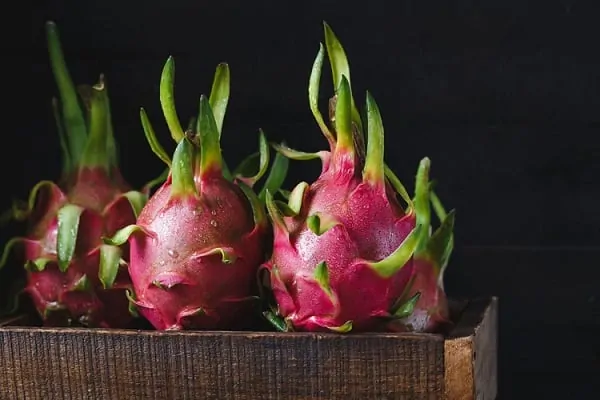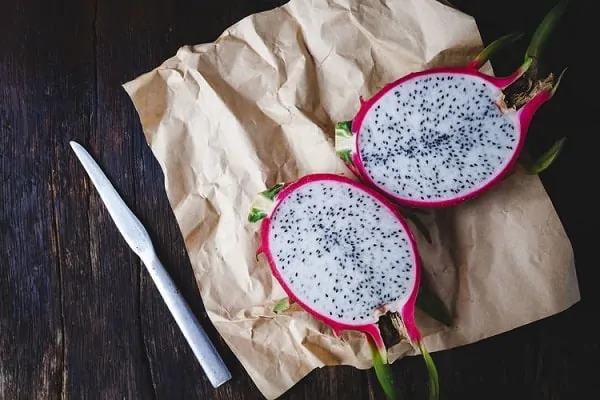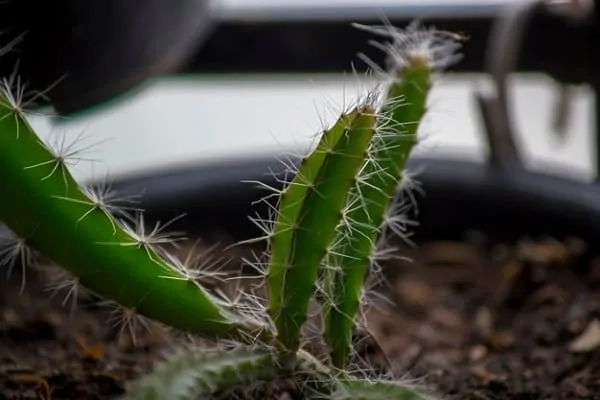How to Grow Dragon Fruit Indoors: Pitaya Plant Growth Guide
Learning how to grow dragon fruit is not hard at all, provided you have a bit of patience and receive the right guidance. Let's learn today how to start your dragon fruit growing adventure if you want to host this amazing cactus in your home!
How to Grow Dragon Fruit Indoors: Pitaya Plant Growth Guide
The dragon fruit plant is a sizable climbing cactus with thick, towering branches that resemble succulents and produces bright red or yellow fruit. The dense, juicy, and sweet fruit of the dragon fruit plant—also known as pitahaya, pitaya, strawberry pears, or cactus fruit—is excellent for eating raw, slicing into salads, or blending into smoothies or ice cream. Dragon fruit is also a nice choice of succulent type that cleanse the air.
Learning how to grow dragon fruit is not hard at all, with a bit of patience and the right guidance. Dragon fruit or the Pitaya plant is technically a vine cactus that loves warm environments. However, if you offer it a sunny porch or a greenhouse, you can enjoy its beautiful flowers and its delicious fruits at home for years to come! Today, we will see together how to grow dragon fruit from seeds, how to grow dragon fruit in pots, and how to care for the dragon fruit in your garden at home!
What is the Dragon Fruit Plant (Hylocereus undatus)?
The dragon fruit is an exotic type of cactus growing in South America, Mexico, Asia, Australia, and some parts of the United States. Hylocereus is a genus of epiphytic cacti; you may often have heard about them under the name of night-blooming cacti. Several Hylocereus species yield large edible fruits, usually known on the market as pitahayas or dragon fruits.
Types of Dragon Fruit Plant
Today we will discuss how to grow dragon fruit of the Hylocereus undatus type. You probably already saw it in the grocery store or even ate it. The fruit features white flesh, small black crunchy seeds, and pink/red skin with soft green spikes. If the fruit does not convince you, let us tell you that the dragon fruit plant yields large yellow-green flowers on the outside.
During the night, they open in scented white, lily-like blooms. In other words, having such cacti in your garden or your home is a thing of beauty.
Some of the most famous dragon fruit plant varieties, besides the pink Hylocereus undatus, are:
- Hylocereus Megalanthus (the Yellow Dragon Fruit) – featuring yellow skin and white flesh;
- Hylocereus costaricensis – featuring purple or red flesh and pink/red skin.
As intimidating as the dragon fruits look, they are incredibly delicious. Dragon fruits’ health benefits are amazing, as they contain high levels of antioxidants, healthy carbohydrates, and omega-three fatty acids.
Who Can Grow the Dragon Fruit Plant?
The dragon fruit plant loves a warm, humid climate and needs little water to thrive. If you want to understand how to grow cacti and succulents in your yard, we recommend you look over our guide here. You can host the dragon fruit in the southern U.S.A. in pots or on your patio, as long as you protect it from extreme temperatures.
If you live in the U.S.A. hardiness zones 10-11, you are in luck, as the dragon fruit can grow in your outdoor garden all year long. We recommend you to check out the U.S.D.A. plant hardiness zone you live in, as, depending on the environmental conditions in your area, you might have to grow dragon fruit in a pot and bring it inside the house in the winter.
How to Grow Dragon Fruit from Seeds
If you want to know how to grow dragon fruit, it is time to discuss how to grow dragon fruit from seeds. The first step here is to choose a healthy organic dragon fruit, cut it in half with care, and remove a couple of seeds. You can do this with a dull knife or even a needle if you have some fine motor skills. Remove any pulp from the seeds with care and place them on a paper towel.
Growing dragon fruit from seeds is not hard, but it takes more time and patience. Here is what you need to grow dragon fruit from seeds!
1. Pot/Container
When you decide to grow dragon fruit at home, one of the most crucial steps is to choose the right container. It should be 15 inches to 24 inches in diameter and more than 10 inches deep. Let’s say you need a 10+ gallons pot provided with a sturdy climbing pole, as dragon fruit is a climbing cactus, as we said. If you do not offer it a large container, the dragon fruit will overgrow and sprawl over the edges of your pot until it finds something to climb.
- Spread a couple of seeds in the container and cover them with a thin layer of soil;
- Some of the seeds will sprout in a few weeks. See which ones take and make sure that you separate the seedlings once they look strong enough for it. In the absence of separation, your dragon fruit plants may not grow to their full potential.
As it grows, make sure you are ready to transplant it into a bigger pot. You can start with sizeable succulent pots to grow dragon fruit from seeds, but eventually, you will need a bigger container. Make sure your container has holes on the bottom to drain the soil thoroughly.
2. Soil
Another crucial aspect of your dragon fruit growing adventure is the soil. Your dragon fruit thrives if it grows in sandy, well-draining potting soil designed for cacti. If you don’t have the right product for your needs, you can create your mix of regular soil, sand, and compost. Fill the container a few inches below its brim.
You may also consider adding a small amount of slow time-release fertilizer at the bottom of the container before planting. It may help your dragon fruit grow faster.
3. Water
Overwatering can kill dragon fruit seeds, seedlings, and grown plants, so you should start on the right foot here. Once you planted the seed, a light mist or a drip will work well only when the soil is dry. You can also consider self-watering planters for cacti to ensure your success with the seed turning into a plant.
4. Light
Now that you have the dragon fruit seeds in a pot place, the container in a sunny spot in your home. Your dragon fruit plant needs at least 6 to 8 hours of full sun to thrive. It tolerates some shade, and it even requires it in scorching climates, but you should always keep an eye on the temperature it receives. The dragon fruit plant fares the best at temperatures ranging between 65 and 85 degrees Fahrenheit. If the temperatures go above 100 F, your plant will die.
So far, we learned how to grow dragon fruit from seeds. Now, it is time to learn how to grow dragon fruit in pots from cuttings. The requirements for growing dragon fruit from cuttings indoors are similar so we will focus a little on the growth from the cuttings process.
How to Grow Dragon Fruit Plants from Cuttings
Experts recommend you grow dragon fruit from cuttings instead of seeds because it takes less time for the plant to grow and yield fruit. We recommend you take a large stem cutting from a professional nursery or a friend that also produces dragon fruit successfully.
- If you obtain a fresh cutting, you should let it dry for about a week in a cool, shady spot. The procedure allows the cutting to heal, thus preventing growth issues or even a plant infection as the cutting takes root.
- The other requirements remain the same. Get a large pot with a sturdy pole and holes on the bottom, pick the best potting soil for cacti, install a drip for the plant’s watering needs, and offer it a place where it can enjoy full sunlight.
- If you want your dragon fruit cuttings to have a chance for success, we also recommend you consider a rooting hormone. Check our guide on the best rooting hormones on the market, pick one designed for cacti and succulents, and use it according to the instructions. The use of such products may jumpstart the growth of your dragon plant from cuttings.
A good dragon fruit cutting will take up to four months to develop strong roots. If you want to fertilize the plant in the meanwhile, we recommend you use a slow-release, low-nitrogen fertilizer for cacti every two months. Keep in mind to offer your dragon fruit cutting just a bit of water only when the soil is dry. As temperatures go, remember that anything below 32F or above 100F will kill the plant.
How to Grow Dragon Fruit: Pro Tips and Considerations
Now that we learned how to grow dragon fruit from seeds and cuttings, it is time to summarize the dragon fruit growth and maintenance requirements.
What the Dragon Fruit Needs to Thrive
Light requirements
Six to eight hours of sunlightWater requirements
Light mist/drip when the soil is dryTemperature
Between 65 and 85 degrees FDifficulty
ModerateWhat Else You Should Know About How to Grow Dragon Fruit and Care for It
Here are some more tips and advice you should consider when you decide to grow a dragon fruit indoors!
- Once your dragon fruit begins to grow, keep the climbing pole moist; use a dripper in this case, as this method will allow you to control better the water intake of your dragon fruit;
- Even if it usually takes months or even years for your dragon fruit plant to get going, you might be lucky and witness some massive growth spurts in a week or two. In this case, your plant can reach a foot in height very quickly. It is an extra reason why you should put the climbing pole in the container from the beginning. Watch out also for possible pests that will invade the plant and inhibit its growth;
- Dragon fruits can become large indoor plants if you offer them the best maintenance, so make sure you transfer them to larger pots with more durable and more reliable poles to climb;
- When you grow dragon fruit from seeds, make sure you separate the plants once they start growing. Each dragon fruit plant needs its turf to thrive;
- Dragon fruits are nocturnal plants, so when and if they bloom, you will likely miss them if you don’t pay attention. Because of its spectacular flowers, most gardeners keep their dragon fruits outdoors, as nothing compares with a night garden party filled with the beauty and scents of this plant.
How to Support, Grow, and Care for Dragon Fruit: Bottom Line
Now you know how to grow dragon fruit indoors. However, there is more to Pitaya than meets the eye. If you live in a hot weather zone, you can plant it in your outdoor garden, just like any succulent or cactus that needs little watering and tolerate drought like a champion.
If you want us to develop on the subject and want to know how to grow dragon fruit outdoors and care for it to yield fruit, let us know in the comment section below, and we will offer you a comprehensive guide!








I woul liek o know more abotu growign dragon fruit, indoors and out. I live in South Texas Zone 9 . What conditions do you need indorrs for sucess? I have no direct sunlight indoors.
Hey I would love to know more about growing dragon fruit indoors, I live in central Canada zone 3b. So indoor growing most of the year, I have a grow tent in my basement.
Hello Erin, thank you for your interest! We are currently updating our posts, so we will include some more info soon! Keep an eye out so you don’t miss the update!
I live in Ontario Canada.
Zone 4.
I just received my very first batch of dragon fruit seedlings..approx.2 inches in length.
I have very little knowledge of growing this beautiful plant..
I am trying to find as much information as possible..
Any advice/suggestions will be truly appreciated!
Thank you
Hi Marina and hello to your seedlings! You’ve come to the right place for info! You need to get your dragonfruit babies some good cactus potting soil, a water drip, and plenty of sun. In zone 4, it’s unlikely it will get over 100F, but the sun passing through a window can still scorch the leaves. I suggest keeping a thermometer next to your pots too, and if it gets too hot, either move them or partially cover the window. Keep us posted on your progress!
I would love more information on growing dragon fruit indoors. Mine are from cuttings and since I got them a year ago I’m just happy I haven’t killed them yet. I’d really like some help.
Generally, you should keep your dragon fruit in a place where it can get between 6 and 8 hours of sunlight. The ideal room temperature is between 65 and 85 F, but be careful not to go over 100 F because the plant will wither. If you follow these simple instructions you are all set, at least with the basics.